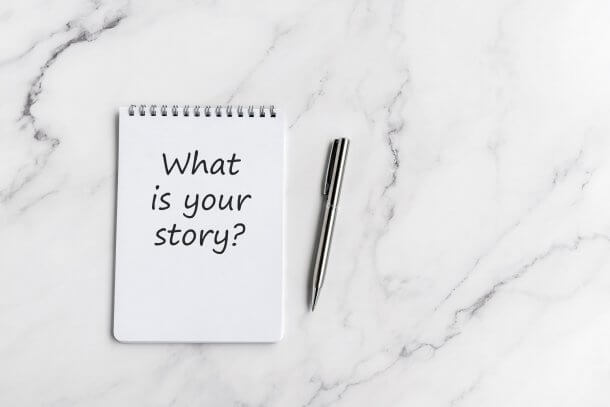06.07.2022 by Anete Ezera
What does 33% mean to you? You’re probably confused about what we’re talking about, and it proves a point – numbers don’t say much. When the context is stripped from the data, the data becomes meaningless. Now, if we were to say that 33% of Americans report feeling extreme stress, you’d have a much clearer picture of the situation. Moreover, 33% would become easier to remember. This simple example perfectly illustrates the power of data storytelling. However, simple text is not enough to fully empower your data. Visual techniques in combination with written narratives make the most effective data stories.
Powerful data stories can elevate your content no matter the topic. Whether you want to prepare a financial statement, publish an engaging news story, or present data to your students, you’ll want to explore data storytelling. Keep reading to discover the necessary ingredients for a powerful data story and learn how to use them in your content.

Click to jump forward:
Why should you use data storytelling?
Ingredients to effective storytelling with data
Use templates and get creative
What is data storytelling?
Data storytelling is a practice where content, context, and design meet to create a compelling narrative where data takes the center stage. Furthermore, storytelling with data allows you to convey important insights using text and visuals.
Visual storytelling is a known marketing technique that uses stories to better communicate with target audiences and sell an idea, product, or service. Stories connect and unify people, and make it easier for your audience to understand and relate to what you’re trying to communicate. Since it’s difficult to create an authentic relationship between a brand and its customers, stories can help to create a common ground. As stated in the Harvard Business Review, a strategic narrative has the power to bring your audience on your journey with you.
Data storytelling takes the power of stories and applies it to data-focused content. Facts and figures are more challenging to grasp on their own, that’s why textual and visual narratives are particularly necessary to carry out any lasting message.

Why should you use data storytelling?
Data insights allow us to reveal patterns, draw conclusions, make better decisions, and inspire action based on what we find. For example, you can make better business decisions based on the data you’ve discovered from the latest market analysis. Or you can inspire action on social media by sharing insightful data on the zero-waste lifestyle.
Sharing data is a means to an end, but in an information-dense environment, consuming data is becoming more difficult. That’s why accompanying your data with a visual, text-based narrative can help your audience to understand and digest the information better.
Ingredients to effective storytelling with data
Now that we have established the what and why of data storytelling, let’s dive into the how.
#1 Have a clear goal in mind
Data storytelling is only effective when you’ve established a clear goal that you’d like to achieve. Do you want to simplify a decision-making process with key insights? Do you want to captivate your audience so they spend more time reading your news article? Or do you want to inspire a certain action based on a shocking statistic?
Whatever goal you may have, pinpoint it before crafting your narrative. This makes it easier to select the right data, visuals, and other insights to support your story and goal. Also, it’ll be easier to remove unnecessary facts and figures that might look cluttered on your infographic, presentation, or any other format.

#2 Choose the right format
Infographic, report, or presentation? Select the format that most appropriately displays your data. The easiest way to determine your data visualization format is to understand where you’ll present it. If you’re preparing a news article, an infographic would be the best choice. However, if you’re presenting something to a group of people, using slides or a dashboard would be the most suitable option.
Also, consider how your audience will interact with the content. If you include an infographic in a blog post, the viewer will scroll through the infographic, increasing the scroll depth of your page. If you plan to publish on social media, use a template that will structure your story to fit on a small phone screen. To help you choose, visit Infogram’s template library and view all types of pre-designed templates.
#3 Make it relevant
Always create with your audience in mind. Think about their level of knowledge, demographics, interests, and other crucial details.
Only include relevant facts and figures that your audience would find interesting or even surprising. Don’t bore people with the information they already know if it’s not leading to something interesting or revelating. Your data story should be based on some level of knowledge your audience already has but is accompanied by new information that captivates their attention.
#4 Have a distinct narrative
What makes a data story an actual story? A clearly defined narrative that takes the reader from beginning to end. Just like in a movie, you need to have an establishing shot that introduces the viewer to the storyline. With that in mind, it’s best not to have charts or graphs right in the beginning, so you don’t confuse the viewer. Instead, include a short sentence or two at the beginning of your data story, establishing the starting point and introducing the reader to the topic you’re about to cover.
Your story should then naturally flow into the more data-rich area, showcasing key insights and essential takeaways. Last but not least, you’ll need to close your story with a statement or a call to action that summarizes your story and inspires further action from the viewer.
#5 Pick your visuals carefully
The purpose of visuals is to simplify and clarify the message for the reader. As visuals are easier to process than text, make sure to use them often enough to create a visually pleasing and easily understandable message. You can use images, icons, stickers, and other visuals to make your data story design more appealing and effective.
The most important element in data storytelling is data visualization. Make sure to pick and choose carefully what kind of charts, graphs, or maps you want to use to visualize your data. If you want to showcase a correlation between two processes, choose line charts. However, if you want to highlight the relationship between two objects, use Sankey or other similar charts.
If you’re not sure what type of visualization to choose, read our blog post on how to choose the right chart for your data.
The most important part of storytelling with data visualization is to simplify your message. Your visualizations need to be easily understood, have enough breathing space so they’re not overpopulated with data, and paint a realistic (not misleading) picture of the data you’re presenting. For a more in-depth look at data visuals, read the best data visualization practices and examples.
#6 Only include good-quality data
Your story is as good as the data it contains. That’s why you should make sure to only use data from reputable sources where the information is accurately represented. The last thing you want is to get called out for untrustworthy sources or inappropriate representations of data.
To be safe, select data from official sources, government websites, peer-reviewed articles, academic journals, and other credible sources. Also, always cite your sources and mention them in your data visualizations. This will increase the credibility of your data.
#7 Level up with interactive elements
How can you make data storytelling more engaging? Turn passive viewers into active participants in your story. Use interactive maps and charts to display data insights and make the data-discovery process more interactive.
When visualizing demographic-based information, opt for interactive maps. Create a map from a variety of options in Infogram’s library and display any kind of information that has a geographical significance. In the map illustrated below, you can hover over different countries to discover data points. Similarly, you can also use interactive charts to visualize, compare, and classify information. You can hover over data points, click and scroll to discover new information, and more. Discover all available charts.
By using interactive maps and charts, you’ll make your data story more dynamic and interactive for your viewers. This is the perfect way to increase the engagement rate for blog posts and news articles.
Use templates and get creative
Data storytelling is a powerful method to not only present important insights but also to create a more memorable experience for your audience. By combining the key data storytelling ingredients, you’ll be able to create an engaging story that captivates your audience.
Make sure to always consider your audience’s interests and needs. Collect data from trusted sources. Also, make use of visuals and interactive elements to design a visually appealing and engaging storyline. If you don’t want to start from scratch, discover Infogram’s templates for infographics, slides, reports, dashboards, and more. Get creative and empower your data with new stories!
Interested in discovering how Infogram can enhance your team’s work? Join a brief Zoom session with our Infogram representative to explore key features, get answers to your questions, and understand how we can assist. It’s quick, informative, and just like a coffee break chat. Schedule your call now!
Get data visualization tips every week:
New features, special offers, and exciting news about the world of data visualization.